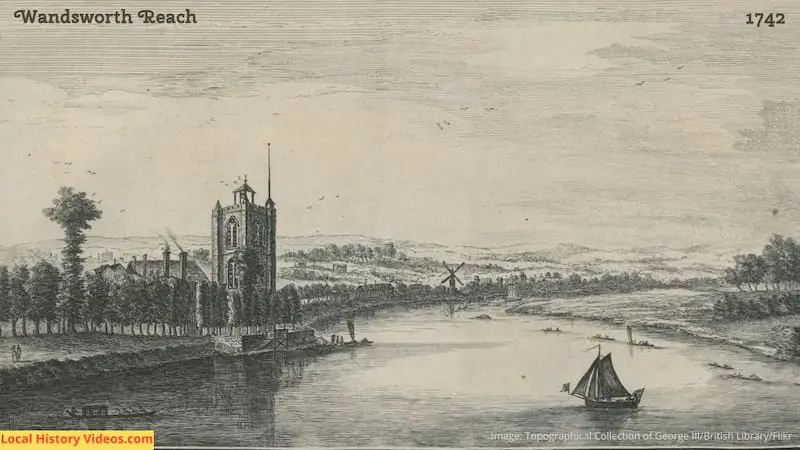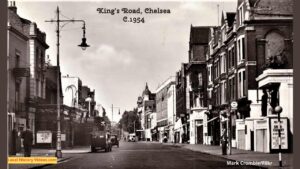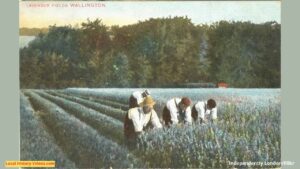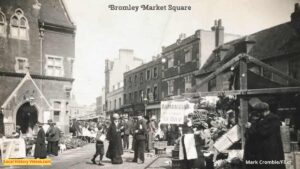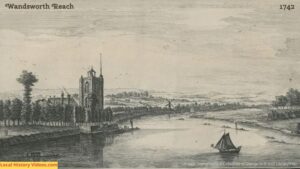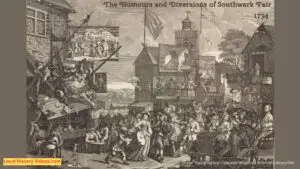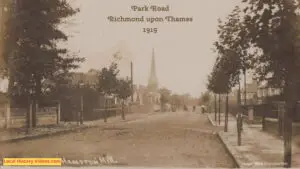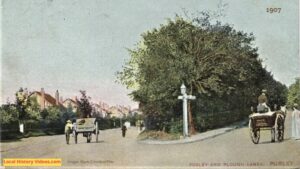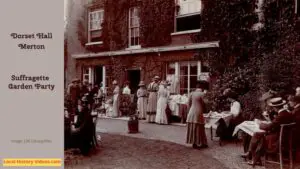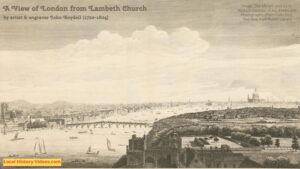Glimpse history through old images of Wandsworth, London, England, UK.
Large Camp 1911
Archive footage show some of the residents at a camp of 120 ‘Galician Gipsies’, as they were then called.
It’s dated 31st December 1911, but neither the subjects of the footage or the local residents standing around are dressed for chilly weather.
GALENCIAN GYPSY CAMP – NO SOUND – British Movietone on YouTube
Slum Clearance 1935
By 1935, nearly half of the borough’s slum areas have been demolished to make way for new housing. The government intended to rehouse 1,300,000 people across the UK.
Here the Minister of Health, Sir Hilton Young, inspects seme of the homes scheduled for demolition.
As the politicians chatter on among themselves, the camera captures houses disappearing before our eyes in a health and safety nightmare, with one onlooker knocked over as a wall falls towards him!
Clearing The Slums (1935) – British Pathé on YouTube
Event at Wandsworth 1936
In 1936, Sir Kingsley Wood, the Minister of Health, attended an event at Wandsworth. It may have been the official opening of the additional block built at Bolingbroke Hospital.
Wandsworth (1936) – British Pathé on YouTube
Queen Mary’s Visit 1937
In 1937, Queen Mary came to officially open Wandworth’s new Civic Centre. She also inspected the proposed infant welfare centre, and the new council suite.
Huge crowds turned out to cheer.
Queen Mary Visits Wandsworth (1937) – British Pathé on YouTube
Air Raid Precautions 1938
The filming of air raid precautions on 15th October 1938 show that even though the start of the Second World War was still almost a year away, the authorities knew that bombing raids on UK soil form part of the coming conflict.
It’s a shame it was all in darkness, so you can’t see the surrounding environment, but in reality the nighttime raids were more common so it was better preparation.
WANDSWORTH AIR RAID PRECAUTIONS – NO SOUND – British Movietone on YouTube
Churchill Visit 1945
In April 1945, Winston Churchill visited Lewisham and Wandsworth, making a couple of stops to speak on a microphone to the assembled crowds.
He was the wartime leader of the country, Prime Minister in a coalition government. A general election was due in the summer, so it was a campaigning visit.
Given that the country was still at war, and the legacy of Churchill as a popular Prime Minister, it’s surprising how many people you can hear booing in amongst the cheers.
CHURCHILL’S TOUR – LEWISHAM AND WANDSWORTH – SOUND – British Movietone on YouTube
Bevan’s Speech 1945
Also campaigning in 1945 was Ernest Bevin, wartime Minister of Labour and MP for Central Wandsworth. It’s a shame we aren’t told the name of the street he is standing in.
Ernest Bevin makes speech in Wandsworth (1945) – British Pathé on YouTube
Wandsworth 1956
Footage dated 8th June 1956 shows Franz Jones visiting Wandsworth’s Town Hall. He’s then seen on the balcony of a flat, before talking to a group of builders.
FRANZ JONES VISITS WANDSWORTH – NO SOUND – British Movietone on YouTube
New Housing 1971
A new estate of 28 blocks of flats, built by Wandsworth Council between Battersea Park and the railway line, created homes for more than 7,000 people.
This footage shows the estate from the air and the ground.
The children play outside unaccompanied by adults, some of them very young. One lad doesn’t have laces on his shoes, while another lad is swinging a pickaxe.
1970s London | Housing Blocks | 1970s Wandsworth | Report | 1971 – British Pathé on YouTube
Concrete Concerns 1984
A news item on 30th November 1984 showed how some of the 1960s concrete tower blocks were causing concern to residents.
Two blocks had been demolished, but the remaining blocks were apparently built with a different type of concrete so were remaining.
One interview is held with Batteresea power station dominating the background. In the final shot, there is a gas storage tower rising into the sky in the corner.
TOWER BLOCKS, WANDSWORTH – Thames News on YouTube
Home Secretary Visit 1987
On 24th April 1987, Home Secretary Douglas Hurd toured a Wandsworth estate which was part of a Neighbourhood Watch area.
POLICE.-Home Beat,Wandsworth. – Thames News on YouTube
1980s Housing
Thames News recorded stock footage of the housing blocks on the Doddington Estate, along with shots of the local shops and the Doddington Residents’ Centre.
There are also images of the inside of the flats. The fitted kitchen was a nice modern one for the era.
Wandsworth| Battersea |1980s Housing Estate | Housing Estate| 1980s London |TN-SL-098-008- Thames News on YouTube
Historic Book
Extract from “Lambourne-Yiewsley” by James Thorne
Published in 1876
Pages 663-666
WANDSWORTH , SURREY , on the river Wandle at its confluence with the Thames, 5 m . from Westminster Bridge , on the road to Kingston.
The L. and S.-W. , and the L. , C. , and D. Rlys . have stations at Wandsworth.
Pop . of the par . 19,783 ; but this includes the vicarage of St. Anne’s Hill , 10,116 , and the eccl . dist . of St. Mary , Summer’s Town , 1435 , and 1853 in St. John’s , Union Road , Battersea .
The name, Dom . Wandelesorde and Wandesore , in early records Wandlesworth, is plainly derived from its situation: it is the worth, or village (i.e. enclosed place), on the river Wandle .
From the increase of London , Wandsworth has become virtually a suburb . It is a busy place , has extensive manufactures and a large trade , and is continuously increasing in population .
On the Wandle , the entrance from South Street , are the Royal Paper Mills of Mr. M’Murray , a very large establishment ; and there are extensive corn mills , distilleries ( Messrs . Watney’s ) , breweries , maltings , dye – works , chemical works , colour factories , cloth printing and bolting mills , match factories , artificial manure works , and so forth ; and the creek at the mouth of the Wandle forms a dock for lighters , with coal wharfs and stores .
By the Thames the ways are narrow and dirty , but away from the river are broader streets lined with good shops ; outside is a vast number of genteel dwellings , and about the Common , and on Cast and West Hills , are many good houses .
The Common has suffered greatly from encroachments and defacements ; but it remains a common still , wide , open , and pleasant; connected, on the one hand, with Putney Heath , on the other with Clapham Common , and running back to Tooting and Streatham Commons .
Aubrey relates that before his time there had been established at Wandsworth a manufacture of “brass plates for kettles, skellets, frying-pans, etc., by Dutchmen, who keep it a mystery.” The houses in which the mystery was carried on were long known as the Frying-pan Houses .
Dye works were in operation here at least as early . Towards the close of the 17th cent . , many of the French Protestants who sought refuge in England upon the revocation of the Edict of Nantes , settled in Wandsworth , and engaged in silk dyeing , hat making , etc.
For their worship they rented and enlarged the old Presbyterian chapel in the High Street , and in it service was performed in French for over a century .
Gradually the French element became absorbed in the surrounding population , but Wandsworth was long famous for hat making .
At the parting of the roads to Clapham and Vauxhall is a small burial – ground – the Huguenots’ Cemetery – where many old gravestones of Frenchmen remain , some almost illegible .
From the many English names on the later gravestones it appears to have been used as the ordinary burial-ground for that end of the parish when the Huguenot population began to die out.
A very different French refugee made Wandsworth for some time his abode. On Voltaire’s release from his second imprisonment in the Bastille , he was ordered to leave France , and he came to England . For two years , 1726-7 , he lived at Wandsworth , the guest of Sir Everard Fawkener , to whom he dedicated ‘ Zaïre . ‘ He was in bad health , but he occupied himself in studying English books , and picked up a sufficient acquaintance with the language to write in it tolerably for the rest of his life .
Wandsworth Bridge . – In 1873 was completed a new iron lattice girder bridge of five spans, connecting York Road , Wandsworth , with King’s Road, Fulham .
Wandsworth has five churches.
The old church ( All Saints ) , in the High Street , near the bridge over the Wandle , is a plain square brick fabric , erected in 1780 , except the tower at the W. end , which was built in 1630 , but recased in 1841 , and raised by the addition of a belfry storey for the reception of a peal of 8 bells , cast by Mears of Whitechapel .
The interior is not more beautiful than the outside , but contains a few interesting monts . from the older ch .
On the E. wall , S. of the chancel , mural mont . of Alderman Henry Smith , died 1627 , with his effigy , in gown and ruff , kneeling at a desk , under an entablature borne on Ionic columns . Beneath is a tablet with an insc . setting forth his numerous benefactions .
Ald . Smith was a native of Wandsworth , of humble lineage ; acquired what was for the time a large fortune by business in the City ; married , but was left a widower without children , and in 1620 , being then 72 years of age , made over his estates , both real and personal , to trustees for charitable purposes , reserving to himself an annuity from them of £ 500 a year for his main tenance . His benefactions embraced every town and almost every parish in Surrey , the object being not merely to afford ” reliefe of the poore , ” but the ” setting them a – worke . ” Smith gave primarily and chiefly to his native county , but his charity was not limited to it . Among other bequests he left £ 1000 to purchase lands , in order to provide a fund for ” redeeming poor captives and prisoners from the Turkish tyranie ; ” £ 10,000 to ” buy impropriations for godly preachers ; ” £ 150 to found a fellowship at Cambridge for his own kindred , etc. The statement on the insc.- ” here lyeth , ” repeated in a Latin insc . on a gravestone below , is inaccurate : there is no trace of interment under the grave – stone ; that and the mont . were removed from the older ch . , and Smith’s burial – place is unknown .
By Smith’s is another mural mont . , with small kneeling effigy of Susanna Powell , d . 1630 , benefactress to this parish , widow of John Powell , servant to Queen Elizabeth, and daughter of Thomas Hayward, yeoman of the guard to Henry VIII., Edward VI . , and the queens Mary and Elizabeth .
N. of chancel , mont . to Sir Thomas Brodrick , died 1641 , and wife, Katherine, d. 1678, with their busts in marble .
Sir Alan Brodrick , Surveyor – General of Ireland , d . 1680 ; Alan Brodrick , 1st Viscount Middleton , d . 1747 ; George Brodrick , 2nd Viscount Middleton , d . 1765 , and other members of the family were also buried here . Their house was at Garrett .
The register records the burial, April 1635, of “Sarah, daughter of Praise Barbone,” supposed to be the ” Praise – God Barebone , ” the Puritan leather-seller of Fleet Street , who gave his name to Cromwell’s first or ” little ” Parliament .
Griffith Clerke, vicar of Wandsworth , his chaplain , his servant , and Friar Ware , were hanged and quartered, at St. Thomas Waterings ( by the Old Kent Road, then the usual place of execution for this part of Surrey), on the 8th of July ,1539 , for denying the royal supremacy.
St. Anne’s Church , St. Anne’s Hill , made a district ch . in 1847 , was erected in 1822-24 from the designs of Sir Robert Smirke , R.A. It is a Grecian temple , 100 ft by 70 , with a hexastyle Ionic portico and pediment at the W. end .
The body of the ch . is of brick with stone dressings , the portico and pediment are of stone . From the roof rises a circular tower in two stages , with engaged columns , and crowned with a cupola and cross : a ch . worth noting as a characteristic example of a past phase of fashion in ecclesiastical architecture .
St. Mary, Summer’s Town, Garrett, was made an eccl. dist . ch . in 1845. The ch. is very poor E.E. , and consists of nave , S. aisle , and bell turret . St. Paul’s , on St. John’s Hill, a chapel – of – ease , belongs as much to Battersea as to Wandsworth.
It is a good Gothic building of stone , with tower and spire , and apsidal chancel .
Holy Trinity , by Wimbledon Park , another chapel-of-ease, is a substantial stone structure ; Gothic , and cruciform ; erected in 1860 , and enlarged in 1870.
There are many dissenting places of worship , one for Friends , and one for Roman Catholics . It should be noted that the first Presbyterian Church in England was founded at Wandsworth in 1572 : their principles of church government and rules of worship were set forth in a publication called The Orders of Wandsworth.’
The secular buildings include a County Court , Police Court , offices of the District Board of Works , banks , large schools , mechanics ‘ institutes , etc. , but none of any architectural interest .
Wandsworth has many almhouses and charitable institutions , and the open country outside has been chosen as the site for several large establishments unconnected with the locality.
On the Common , near the Clapham Station , is the Royal Patriotic Asylum , founded and endowed from the surplus funds of the Crimean Patriotic Fund of 1854 , for the nurture and education of orphan children of soldiers , sailors , and marines.
The first stone of the asylum for girls was laid by the Queen , July 11 , 1857. The building , intended for the accommodation of 300 children , was designed by Mr. Rhode Hawkins , as a free imitation – with some important deviations and the omission of the ornamental details – of Heriot’s Hospital , Edinburgh .
At a short distance is a correspondent asylum for boys; but the establishments are quite distinct.
The large quaint – looking red brick Gothic building , with great central clock – tower , and overhanging watch towers at the angles , seen above the railway cutting , is the Freemasons ‘ Female Orphan Asylum , erected , 1852 , from the designs of Mr. Philip Hardwick .
In Spanish Road , Wandsworth Common , is the Friendless Boys ‘ Home , a valuable refuge for boys from 10 to 16 years of age , “who have lost character , or are in danger of losing it.” It is said that of the lads who pass through the school about 75 per cent are reclaimed . About 200 are now in training .
At East Hill is St. Peter’s Hospital, the Almshouse of the Fishmongers’ Company, a spacious , solid , and comfortable looking range of buildings , occupying 3 sides of a quadrangle , with a chapel in the centre , erected 1849-51.
The Royal Hospital for Incurables , West Hill , is noticed under PUTNEY .
On the Common will also be observed two enormous piles of buildings , the Surrey Lunatic Asylum and the County Prison.
The former , erected in 1840 , from the designs of Mr. Wm . Moseley , is a late Tudor structure , consisting of centre and advanced wings , 535 ft . long , and provides accommodation for 950 inmates.
The Surrey House of Correction , an equally huge group of brick and stone buildings , erected in 1851 , makes provision for 1000 convicted criminals , with all appliances for labour , instruction , and sickness .
The Union Workhouse , East Hill , is another vast brick pile , affording accommodation for 850 paupers , with a large infirmary attached.
More Pictures of Old Wandsworth
Old Wandsworth in London, England, enjoyed through historic photos, vintage pictures & archive film. Browse history in these fascinating old images of a bygone era on my Pinterest Board:
https://www.pinterest.co.uk/LocalHistoryVideos/wandsworth-old-photos-pictures
More about Greater London
- Chelsea, London: History in Old ImagesEnjoy a glimpse of history through old images of Chelsea in Greater London, England, UK.
- Wallington, London: History in Old ImagesEnjoy a glimpse of history through old images of Wallington, in Greater London, England, UK.
- Bromley, London: History in Old ImagesEnjoy a glimpse of history through old images of Bromley, in London, England, UK.
- Old Images of Wandsworth, LondonGlimpse history through old images of Wandsworth, London, England, UK. Large Camp 1911 Archive footage show some of the residents at a camp of 120 ‘Galician Gipsies’, as they were then called. It’s dated 31st December 1911, but neither the subjects of the footage or the local residents standing around are dressed for chilly weather.… Read more: Old Images of Wandsworth, London
- Old Images of Southwark, LondonGlimpse history through old images of Southwark, London, England.
- Old Images of Richmond upon Thames, LondonGlimpse history through old images of Richmond upon Thames, London, England, UK.
- Old Images of Purley, LondonGlimpse history through old images of Purley, London, England, UK.
- Old Images of Merton, LondonGlimpse history through old images of Merton, London.
- Old Images of Lewisham, Southeast LondonGlimpse history through old images of Lewisham, in Southeast London, England.
- Old Images of Lambeth, LondonEnjoy a glimpse of history through old images of Lambeth, London, England.

